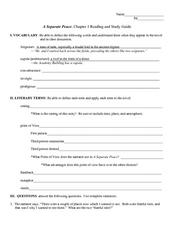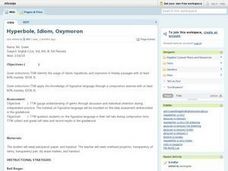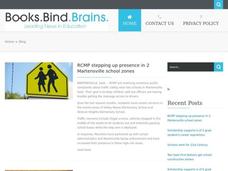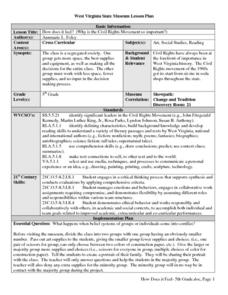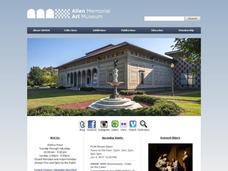Curated OER
Women's Achievements
Third graders read the passage in their textbook about Mary McLeod Bethune and discuss why education was important to her, and why she beleived that education allowed African American children to reach their potential. They then discuss...
Curated OER
A Separate Peace: Chapter 1 Reading and Study Guide
In this reading and study guide worksheet, learners define 3 vocabulary words, define 5 literary terms, and respond to 14 short answer questions pertaining to chapter 1 of John Knowles's A Separate Peace.
Curated OER
Causation-Exploration and World Trade
Students investigate spice trade. In this world history lesson, students identify various spices in jars and their places of origin. Students listen to a lecture on how spices came to countries in Europe. Students complete a source...
Curated OER
Greco-Roman Origin Myths
Students explore myths that explain the world, recognize some characters of Greco-Roman mythology and their symbols, and Make personal connections to the theme by writing and drawing a myth of their own.
Curated OER
Stocking Up For The Next Millennium
Look back on the inventions, concepts, cultural items, and literary contributions of the past one hundred years. Young historians will compose a presentation based on the research they do in favor of one thing that should withstand the...
Curated OER
Quilting Our Communities
Students share personal artifacts and use them to make a classroom community quilt.
Curated OER
Lesson Plan on Korea
Students participate in a lesson about ancient pottery making in Korea. The time of the research goes back to the 12th century. They read a story and study the attributes of characterization that the author uses.
Curated OER
Anglo-Saxon Period: An Introduction
High schoolers read information about Anglo-Saxon rulers and literary techniques, then complete a worksheet to help them review. Students take notes about the oral tradition, Anglo-Saxon literary terms, and Anglo-Saxon poetry. High...
Curated OER
Then, Now, and Tomorrow
Students will use this unit to investigate the past, present, and future of the architecture and plan of New York's Lower East Side. Students will research the history of the Lower East Side neighborhood in photographs used from the...
Curated OER
Comparative World Mythology
After a brief review of the areas that can be selected for the project, I would discuss myths with the students, dispelling any misconceptions about mythology that the students may have. The students would then break into groups and I...
Curated OER
Hyperbole, Idiom, Oxymoron
Fourth graders identify the usage of idiom, hyperbole, and oxymoron in literary passages. They apply this knowledge of figurative language through a composition exercise. The writing of teacher generated examples is also helpful.
Curated OER
Anti-Semitism Throughout the Ages
Learners investigate the implication of anti-Semitism. In this prejudice lesson, students compare anti-Semitism to bullying as they research the propaganda techniques employed during the Holocaust and throughout history.
Curated OER
Maya Lin - Artist, Architect, Environmentalist
Sixth graders explore the life of Maya Lin and analyze the impact of her architectural philosophy on her work. They trace the history of the Vietnam Memorial from its conception by Maya Lin, to the present day. A time line is created of...
Curated OER
"West Side Story"
In this music history worksheet, students discover the musical "West Side Story" by first reading a summary of the plot. Students answer 5 questions about the story line. Students then read and analyze the lyrics to "America" and discuss...
Curated OER
Dekanawidah- A Forgotten Founding Father
Students compare plans for government. In this early American history lesson, students compare and contrast the U.S. Constitution with the Iroquois Constitution. Students identify cultural features, government functions, and citizenship...
Curated OER
Governance
Students explore government by researching Native American history. In this First Nations culture lesson plan, students define the Aboriginal action of speaking in a circle as a group. Students discuss their likes and dislikes with the...
Curated OER
Fly, Fly Away
Students use materials from their own environment to design a kite. In this kite design lesson, students research the history of kites and obtain a formal mathematical definition of a kite. Students sketch kite designs after discovering...
Curated OER
How does it feel? Why is the Civil Rights Movement so Important?
Fifth graders study the Civil War. In this US history lesson, 5th graders simulate what life was like during the Civil War by having two groups with one group given more materials than the other group. Students then draw a portrait of...
Curated OER
Fight For Your Right - Leading A Revolution of Change
Students examine civil rights. In this civil rights lesson, students research human rights issues of United States history. Students then discuss their research findings and write Bill of Rights statements for the topics they researched.
Curated OER
How the Electoral College Works
Pupils research the history and mechanics of the Electoral College and formulate opinions as to whether this institution should be preserved, modified or eliminated. They predict future outcomes of electoral vs. popular votes.
Curated OER
The Iditarod Trail
Young scholars research and read about the Iditarod Trail and then make a presenation showing their findings.
Curated OER
Japanese Carp Kites/Children's Day
Students listen to the story "A Carp for Kimiko" and discuss its lesson and theme. They design and create their own carp kite in celebration of Children's Day. They discuss gender discrimination and how that makes them feel.
Curated OER
Exploring the Self
High schoolers use different pieces of music and writings to explore the theme of self-reliance and individuality. After viewing a video clip, they discuss how the images made them feel. They keep a writing journal to evaluate their...



